Business Plan Instructions PDF

| Title | Business Plan Instructions |
|---|---|
| Course | Internet for Business |
| Institution | Royal Melbourne Institute of Technology |
| Pages | 4 |
| File Size | 178.8 KB |
| File Type | |
| Total Downloads | 36 |
| Total Views | 126 |
Summary
Instructions for Business Plan Assignment...
Description
Assessment task 2: Business Plan Marks available: 30 (converted to 20% of your overall mark) Due date: see the Syllabus Each student is to submit a Business Plan for a website-based business. The business must derive its income directly from products or services sold through the website. Your Business Plan must demonstrate an understanding of online business as outlined in the Lectures. Lectures 3 through 7 are particularly important. Your idea for a website-based business must have been approved by the ISYS2061 teaching team before you begin the Business Plan development. To gain approval, submit your business idea by email through the Inbox on your ISYS2061 Canvas site before the date required in the Syllabus. Length: up to 3000 words Submission – develop your Business Plan as a Word document and submit it through your ISYS2061 Canvas as a Turnitin assignment. There will be a submission link called Assignment Inbox at the bottom of the Assessment task 2: Business Plan page. You can find this page under Assignments in your ISYS2061 Canvas. Submitted in this way, your Business Plan will be scanned to make sure it is your own work. Very Important - as part of submitting your Business Plan through Turnitin you will receive an Originality report. Turnitin will compare your Business Plan with heaps of published papers and other assignments submitted to RMIT including previous Business Plans submitted to ISYS2061. Your Originality Report may take Turnitin a number of hours to produce after you have submitted your Business Plan. Have a good look at your Originality report. If the report suggests that your Business Plan is not entirely your own work you have until the Business Plan due date to do something about it. If your Originality report after the due date is not satisfactory you will be asked to explain the similarities that Turnitin has found. Similarities include cleverly rewording a previously submitted Business Plan. If you cannot explain any similarities you will be referred to the RMIT plagiarism process. You can use ideas and facts (not words) from other published sources to support your Business Plan. These ideas and facts must be cited within your Business Plan and in a Reference List at the end of your Business Plan. Please remember that if you have developed a Business Plan for one course you cannot use it in another.
1
A business plan is a document to help organise the start-up of a business and to encourage potential investors and loan givers. Please keep this in mind as you write your plan. Your Business Plan is to include only the following sections and each dot point must be addressed. Use a heading for each section. Do NOT use a Business Plan structure from anywhere else. 1. Line of business (3 marks) • A suitable name for the company that reflects its line of business • Domain name (that you have checked is available at http://www.domainregistration.com.au/domains/). Please provide a screen grab showing that the name is available. • The essential nature of the products or services your website will sell (one paragraph). If you are selling products please indicate the source of your products – are you manufacturing them yourself; are you purchasing them from suppliers and storing them in a warehouse; or are you ordering them directly from a supplier as a customer makes an order. 2. Purpose of introducing e-commerce (2 marks) • Describe 2 ways that being online will improve your business. Your description must not be a simple repetition of the Lecture notes. You need to apply the Lecture notes to your proposed business. j 3. Marketing plan (6 marks) • You need to understand at least one large group of people that will want to do business with you so you can cater to them – your target customers. Describe this group of people. Give an age and income range. What interests do they have? Be specific. • Research two online competitors. Describe their businesses. Describe the weaknesses that you will exploit. You may not choose to compete on price unless you have a sensible reason why you can source goods cheaper than your competitors. Out of your competitors’ weaknesses you need to explicitly describe one competitive advantage your business will use. This competitive advantage will be highlighted at the top of the home page of your website so is very important. What are you offering that your competition does not. You must use the phrase “competitive advantage” in your response. • Describe 2 advertising strategies that you will use to attract visitors to your website obviously not features of the website as these only relate once the customer has found you. At least one of the strategies must be online. Be specific. Please do not make sweeping statements like “I will use social media”. Your advertising strategies must put the URL of your website in the face of your potential customers. 4. Revenue model (8 marks) a) Setup and maintenance costs (5 marks) • Find two possible website hosts and compare what they offer and their cost. Choose a website host for your business.
2
• Make a sensible estimate of labour costs for the first year of operation. Justify this cost in terms of the role the employees will play and their wage. If you want to be an employee (do some of the work) then you must include a living wage for yourself. If you intend using your own home as a warehouse or office you must include a reasonable cost. Potential investors will want to see the costs of your business as if it was not running from your home. Your website must be updated regularly and customer complaints handled so this will involve labour regardless of your business model. You may also need to dispatch goods or negotiate supplies. You also need some accounting services for tax at the least. • Make a sensible estimate of any other costs likely to be incurred in your first year of operation. Other costs could include equipment so you can answer emails, rent, insurance, utilities, advertising and so on. Think widely. You will not be penalised if your amounts are incorrect but they must be sensible. • You must give a total cost for the first year of your business. Present your costs; Labour, Other, and Total; in a Table b) Income (3 marks) Income streams are covered in the Lectures. They include profit from sales, subscription and business alliances (such as advertising revenue). If using advertising then your customer is really the advertiser and you must write your business plan in terms of those advertisers and your value proposition to them. • How much income do you expect in the first year? From what sources will the income be derived? Sensible estimates are expected. For instance, you cannot expect to have thousands of transactions in your first few months. Nobody knows about your website. You cannot expect to make $1 million dollars profit in your first year, either. Otherwise, why would you be wasting your time at Uni? Base your income estimate on how many transaction will be made for the year and how much money will be made from each transaction. If you use a more complex revenue stream then you can just make an estimate that includes the number of transactions that will be needed to cover costs. Better answers will provide a table giving monthly estimates of income. This recognises that very few transactions are likely in the first few months. • You must give a total income value for the first year. • Give a profit or loss figure for the first year based on income minus costs 5. Website design (6 marks) For a website-based business it is important to consider the design of the website early in the process of preparing a Business Plan. Any potential investors in a website-based business will want to know that the website design has been well thought through, • Prepare a site map for your website. This map documents the pages that will make up the website you will create in Wix for your Website assignment. Have a read of the Website Instructions to make sure you have the appropriate number of pages in your Website. 8 pages is what you should have. If you have chosen a large, complex business idea then you need to decide which part of the business you will use for the Website assignment. See section 2 of Session 2 for an example of a site map. It has one box for each web page and lines showing which pages are linked to each other.
3
You can do this as a picture inserted in to your Word document or as text using ---and | • Give details as to the features on the home page of your website that will entice viewers to look at your website in detail rather then take a cursory glance. These features will essentially involve: 1. How you present what your business is selling and, 2. How you present your competitive advantage. What images and text will you use on your home page to convey your products or services and your competitive advantage? You must use the phrase “competitive advantage” in your response. • Assume that your home page has attracted viewers to stay on your website. How is your home page to be designed so that visitors are converted in to customers? What will entice your visitors to purchase your products or services? This relates to your value proposition. In other words, what value propositions are you presenting to your website visitors? These propositions may be in the form of first-time buyer discounts, for example. Think widely. You must use the phrase “value proposition” in your response. A further 5 marks are allocated to how well you have demonstrated in your Business Plan an understanding of Lectures 3 through 7. We are not looking for a repeat of the theory. Rather, we are looking for the application of the theory to your specific business. We will count the concepts and terms from the Lecture notes in your business plan to decide your mark. As an example, you should name the e-commerce model that you are using for your business. Contact the ISYS2061 teaching team via the Inbox on your ISYS2061 Canvas site if you have any queries. Marking Scheme Feature Line of business Purpose of introducing e-commerce Marketing plan Revenue model – costs and income Website design Understanding of Lectures 3 through 7 Total
Possible Mark 3 2 6 8 6 5 30
4...
Similar Free PDFs

Business Plan Instructions
- 4 Pages

CUE- Business-PLAN - Business plan
- 10 Pages

Business-Plan - Business plan Enc
- 48 Pages

FP21T0 Plan Instructions
- 27 Pages
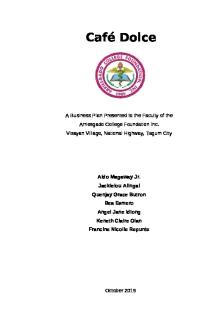
Business Plan
- 26 Pages

Business PLAN
- 3 Pages
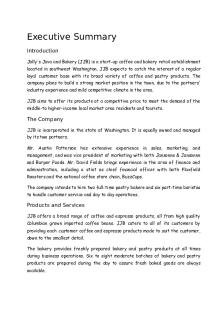
Business PLAN
- 21 Pages
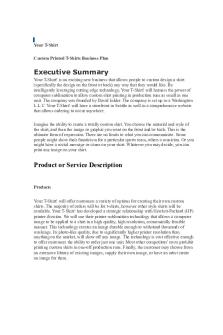
Business PLAN
- 10 Pages

BUSINESS PLAN
- 24 Pages
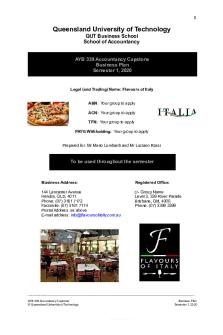
Business Plan
- 28 Pages
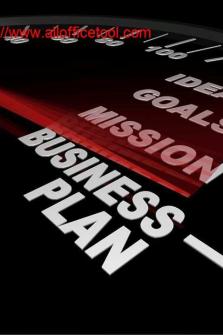
Business Plan
- 21 Pages
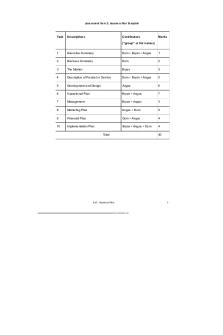
Business plan
- 40 Pages
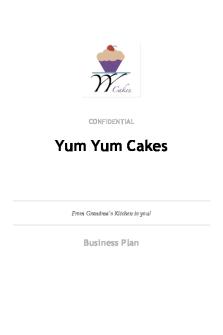
Business Plan
- 47 Pages

Business Plan
- 10 Pages
Popular Institutions
- Tinajero National High School - Annex
- Politeknik Caltex Riau
- Yokohama City University
- SGT University
- University of Al-Qadisiyah
- Divine Word College of Vigan
- Techniek College Rotterdam
- Universidade de Santiago
- Universiti Teknologi MARA Cawangan Johor Kampus Pasir Gudang
- Poltekkes Kemenkes Yogyakarta
- Baguio City National High School
- Colegio san marcos
- preparatoria uno
- Centro de Bachillerato Tecnológico Industrial y de Servicios No. 107
- Dalian Maritime University
- Quang Trung Secondary School
- Colegio Tecnológico en Informática
- Corporación Regional de Educación Superior
- Grupo CEDVA
- Dar Al Uloom University
- Centro de Estudios Preuniversitarios de la Universidad Nacional de Ingeniería
- 上智大学
- Aakash International School, Nuna Majara
- San Felipe Neri Catholic School
- Kang Chiao International School - New Taipei City
- Misamis Occidental National High School
- Institución Educativa Escuela Normal Juan Ladrilleros
- Kolehiyo ng Pantukan
- Batanes State College
- Instituto Continental
- Sekolah Menengah Kejuruan Kesehatan Kaltara (Tarakan)
- Colegio de La Inmaculada Concepcion - Cebu

